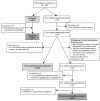The international, prospective Glanzmann Thrombasthenia Registry: treatment and outcomes in surgical intervention
- PMID: 26001792
- PMCID: PMC5004419
- DOI: 10.3324/haematol.2014.121384
The international, prospective Glanzmann Thrombasthenia Registry: treatment and outcomes in surgical intervention
Abstract
Standard treatment for Glanzmann thrombasthenia, a severe inherited bleeding disorder, is platelet transfusion. Recombinant factor VIIa is reported to be effective in Glanzmann thrombasthenia with platelet antibodies and/or refractoriness to platelet transfusions. We aimed to evaluate recombinant factor VIIa effectiveness and safety for the treatment and prevention of surgical bleeding in patients, with or without platelet antibodies and/or refractoriness, using data from the Glanzmann Thrombasthenia Registry, an international, multicenter, observational, post-marketing study of rFVIIa. Between 2007 and 2011, 96 patients were treated for 206 surgical procedures (minor 169, major 37). History of platelet antibodies was present in 43 patients, refractoriness in 23, antibodies+refractoriness in 17, while 47 had no confirmed antibodies/refractoriness. Treatments analyzed included antifibrinolytics, recombinant factor VIIa, recombinant factor VIIa+antifibrinolytics, platelets±antifibrinolytics and recombinant factor VIIa+platelets±antifibrinolytics. The most frequent treatment for minor procedures was recombinant factor VIIa+antifibrinolytics (n=65), and for major procedures, recombinant factor VIIa+platelets±antifibrinolytics (n=13). In patients without antibodies/refractoriness, recombinant factor VIIa, either alone or with antifibrinolytics, and platelets±antifibrinolytics were rated 100% effective for minor and major procedures. The effectiveness of treatment for minor procedures in patients with antibodies and refractoriness was 88.9% for recombinant factor VIIa, 100% for recombinant factor VIIa+antifibrinolytics, 66.7% for platelets±antifibrinolytics and 100% for recombinant factor VIIa+platelets±antifibrinolytics. One of four adverse events reported for surgery was considered recombinant factor VIIa-treatment-related (non-fatal thromboembolic event in an adult female receiving recombinant factor VIIa+platelets+antifibrinolytics). For all patients, regardless of platelet antibody or refractoriness status, recombinant factor VIIa, administered with or without platelets (±antifibrinolytics), provided effective hemostasis with a low frequency of adverse events in surgical procedures in Glanzmann thrombasthenia patients. This trial was registered at clinicaltrials.gov identifier: 01476423.
Trial registration: ClinicalTrials.gov NCT01476423.
Copyright© Ferrata Storti Foundation.
Figures

References
-
- Bellucci S, Caen J. Molecular basis of Glanzmann’s Thrombasthenia and current strategies in treatment. Blood Rev. 2002;16(3):193–202. - PubMed
-
- George JN, Caen JP, Nurden AT. Glanzmann’s thrombasthenia: the spectrum of clinical disease. Blood. 1990;75(7): 1383–1395. - PubMed
-
- Toogeh G, Sharifian R, Lak M, Safaee R, Artoni A, Peyvandi F. Presentation and pattern of symptoms in 382 patients with Glanzmann thrombasthenia in Iran. Am J Hematol. 2004;77(2):198–199. - PubMed
-
- Fiore M, Firah N, Pillois X, Nurden P, Heilig R, Nurden AT. Natural history of platelet antibody formation against αIIbβ3 in a French cohort of Glanzmann thrombasthenia patients. Haemophilia. 2012;18(3):e201–e209. - PubMed
-
- Hod E, Schwartz J. Platelet transfusion refractoriness. Br J Haematol. 2008; 142(3):348–360. - PubMed
Publication types
MeSH terms
Substances
Associated data
LinkOut - more resources
Full Text Sources
Other Literature Sources
Medical

